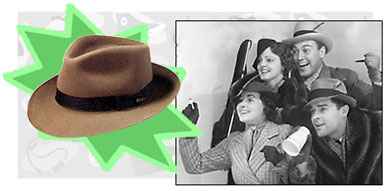Fedora hats

Fashion Synopsis
Bogey, Sinatra, Indiana Jones. Without their fedora hats, would they be the same?
The fedora took its name from a 1882 French play, Fedora, by Victorien Sardou. The center-creased crown and tapered-brim hat was a popular style for both men and women of the late 19th century, and became inseparable from the neatly Brylcreemed heads of men up until the early 60’s. Perched jauntily on the noggin’, the fedora was über-cool sophistication.
The fedora was the modern man’s choice of headwear for the first half of the 20th century, but when John F. Kennedy made his inauguration speech in 1961—hatless—the fedora lost its flavor. The wearing of hats declined along with traditional values during the revolutionary 60’s. Just like Clark Gable single-handedly destroyed the undershirt market in 1932 when he appeared bare-chested in It Happened One Night, President Kennedy influenced a nation of men to hang up their hats.
Fedoras returned at the end of the 70’s, but this time on women. Diane Keaton’s masculine style in Annie Hall influenced women to dust off their father’s fedoras hiding in the back of the closet, and embrace the unisexy style. Nostalgia nut Michael Jackson returned the everyman’s hat to the crown when he sported a fedora hat as part of his personal uniform of the 80’s. And the infamous archeologist Indiana Jones never let his hat leave his head. These three major influences resurrected the much loved and debonair fedora for the post-baby boom generation.
But the most memorable moment for the fedora will always be from the 1942 classic, Casablanca. Bogey stood on the airstrip, his trench coat cinched around his waist, his fedora pulled low to shadow his sullen eyes: “Here’s looking at you, kid.”
Fashion Sub Categories
girl's apparelboy's apparel
accessories
